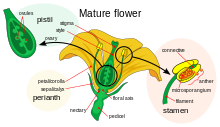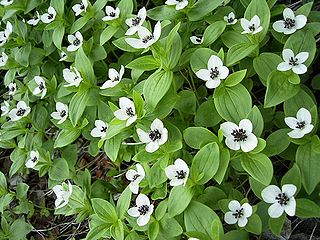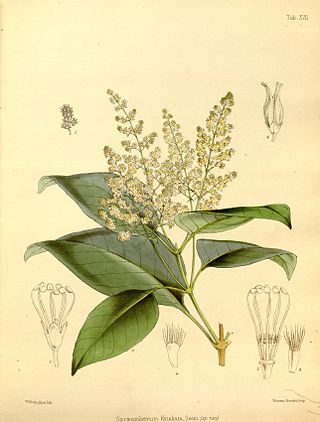
In botany, the style of an angiosperm flower is an organ of variable length that connects the ovary to the stigma. The style does not contain ovules; these are limited to the region of the gynoecium (female organs of the flower) called the "ovary."

In botany, the style of an angiosperm flower is an organ of variable length that connects the ovary to the stigma. The style does not contain ovules; these are limited to the region of the gynoecium (female organs of the flower) called the "ovary."
The style is a narrow extension of the ovary, usually pointing upwards, connecting the ovary to the stigmatic papillae. It may be absent in some plants; in this case, it is referred to as a sessile stigma. Styles generally resemble more or less long tubes. The style can be open (with few cells occupying the central part, or even none), featuring a central canal that may be filled with mucilage. Alternatively, the style can be closed (completely filled with cells). Most plants with syncarpous pistils (monocotyledons and some eudicotys) have open styles, whereas many eudicots and grasses have closed (solid) styles containing specialized secretory tissues, which connect the stigma to the center of the ovary. These tissues form a nutrient-rich cord for the growth of the pollen tube. [1]
When the pistil consists of several carpels, each of them may have a distinct stylodium (pseudo-style[ verification needed ]) or share a common style. In Iris and other species of the Iridaceae family, the style divides into three "petaloid branches" (resembling petals), sometimes also called stylodiums, [1] almost at the origin of the style and is called "tribrachiate". These are strips of tissue emerging from the perianth tube above the sepal. The stigma is a ridge or edge on the lower surface of the branch, near the tip of the lobes. [2] Branched styles also appear in the genera Dietes , Pardanthopsis, and in most species of the genus Moraea . [3]
In Crocus species, the style is branched into three "branches," forming a tube. [4] Plants of the genus Hesperantha have a spread-out branched style. The style can also be lobed rather than branched. Plants of the genus Gladiolus have a bilobed style. In the genera Freesia , Lapeirousia , Romulea , Savannosiphon , and Watsonia , the style has bifurcated and curved branches. [5] [6]
May be terminal (apical), subapical, lateral, gynobasic, or subgynobasic. Terminal (apical) style position refers to attachment at the apex of the ovary and is the most common pattern. In the subapical pattern, the style arises to the side slightly below the apex. A lateral style arises from the side of the ovary and is found in Rosaceae. The gynobasic style arises from the base of the ovary, or between the ovary lobes and is characteristic of Boraginaceae. Subgynobasic styles characterise Allium . [7]
Pollen tubes grow the length of the style to reach the ovules, and in some cases self-incompatibility reactions in the style prevent full growth of the pollen tubes. In some species, including Gasteria at least, the pollen tube is directed to the micropyle of the ovule by the style. [8]

The Cornaceae are a cosmopolitan family of flowering plants in the order Cornales. The family contains approximately 85 species in two genera, Alangium and Cornus. They are mostly trees and shrubs, which may be deciduous or evergreen, although a few species are perennial herbs. Members of the family usually have opposite or alternate simple leaves, four- or five-parted flowers clustered in inflorescences or pseudanthia, and drupaceous fruits. The family is primarily distributed in northern temperate regions and tropical Asia. In northern temperate areas, Cornaceae are well known from the dogwoods Cornus.

Hydrangeaceae is a family of flowering plants in the order Cornales, with a wide distribution in Asia and North America, and locally in southeastern Europe.

Cunoniaceae is a family of 27 genera and about 335 species of woody plants in the order Oxalidales, mostly found in the tropical and wet temperate regions of the Southern Hemisphere. The greatest diversity of genera are in Australia and Tasmania, New Guinea, and New Caledonia. The family is also present in Central America, South America, the Caribbean, Malesia, the islands of the South Pacific, Madagascar and surrounding islands. the family is absent from mainland Asia except from Peninsular Malaysia, and almost absent from mainland Africa apart from two species from Southern Africa. Several of the genera have remarkable disjunct ranges, found on more than one continent, e.g. Cunonia, EucryphiaWeinmannia.

The stigma is the receptive tip of a carpel, or of several fused carpels, in the gynoecium of a flower.
Bhesa nitidissima is a species of plant in the Centroplacaceae family. It is endemic to Sri Lanka.

Spiraeanthemum is a genus of trees and shrubs in the family Cunoniaceae. it includes about 19 species from Australia, New Guinea, Solomon Islands, New Caledonia, Vanuatu, Fiji and Samoa. Leaves are simple, opposite or whorled, with toothed or entire margins. Inflorescences are paniculate, flowers unisexual or hermaphrodite, and the fruits are follicular with free carpels. It belongs to the tribe Spiraeanthemeae, and now includes the species formerly placed in Acsmithia.

Cunonia is a genus of shrubs and trees in the family Cunoniaceae. The genus has a disjunct distribution, with 24 species endemic to New Caledonia in the Pacific, and one species in Southern Africa. Leaves are opposite, simple or pinnate with a margin entire to serrate. Interpetiolar stipules are often conspicuous and generally enclose buds to form a spoon-like shape. Flowers are bisexual, white, red, or green, arranged in racemes. The fruit is a capsule opening first around the base then vertically, seeds are winged.

Lepidobotryaceae is a family of plants in the order Celastrales. It contains only two species: Lepidobotrys staudtii and Ruptiliocarpon caracolito.

Hydrostachys is a genus of about 22 species of flowering plants native to Madagascar and southern and central Africa. It is the only genus in the family Hydrostachyaceae. All species of Hydrostachys are aquatic, growing on rocks in fast-moving water. They have tuberous roots, usually pinnately compound leaves, and highly reduced flowers on dense spikes.

The Maleae are the apple tribe in the rose family, Rosaceae. The group includes a number of plants bearing commercially important fruits, such as apples and pears, while others are cultivated as ornamentals. Older taxonomies separated some of this group as tribe Crataegeae, as the Cydonia group, or some genera were placed in family Quillajaceae.
Klaus Kubitzki was a German botanist. He was Emeritus professor in the University of Hamburg, at the Herbarium Hamburgense. He is known for his work on the systematics and biogeography of the angiosperms, particularly those of the Neotropics, and also the floristic record of the Tertiary era. His plant systematic work is referred to as the Kubitzki system. He was a member of the American Society of Plant Taxonomists.

Lamanonia is a genus of trees in the family Cunoniaceae. It is endemic to South America.

Aistopetalum is a genus of trees in the family Cunoniaceae. It is endemic to New Guinea and includes two species: Aistopetalum multiflorumSchltr. and Aistopetalum viticoidesSchltr..
Opocunonia is a monotypic genus of trees in the family Cunoniaceae. Its only species is Opocunonia nymanii, synonym Caldcluvia nymanii. It is native to New Guinea and the Bismarck Archipelago.

Platylophus trifoliatus is a species of trees in the family Cunoniaceae. It is endemic to South Africa and the only species of the genus Platylophus. Leaves are opposite with three leaflets. Flowers are creamish or yellowish and arranged in axillary thyrsoid inflorescences. Fruits are indehiscent. Its closest relative is the Tasmanian endemic Anodopetalum.
Nicobariodendron is a genus in the family Celastraceae, with only one species, Nicobariodendron sleumeri, a tree with simple, alternately set, entire leaves, small flowers and single seed fleshy fruits. It is only known from the Nicobar Islands of India.
Fraunhofera is a genus of flowering plants in the family Celastraceae. It has only one species, Fraunhofera multiflora, called pau branco, which is a Brazilian endemic. Found in deciduous forests of Brazil, they are little-studied shrubs or trees, and only immature fruit have ever been observed.

Putterlickia, variously called spikethorns, false spike thorns, mock spike thorns and bastard spike thorns, are a genus of flowering plants in the staff vine and bittersweet family Celastraceae, native to South Africa, Eswatini and Mozambique. Endophytic bacteria in their roots produce maytansine.
Quetzalia are a genus of flowering plants in the staff vine and bittersweet family Celastraceae, disjunctly distributed in Mexico, Central America, and Brazil. They can be trees, shrubs or lianas. Cyrus Longworth Lundell split them off from Microtropis in 1970, overriding his own 1939 findings.